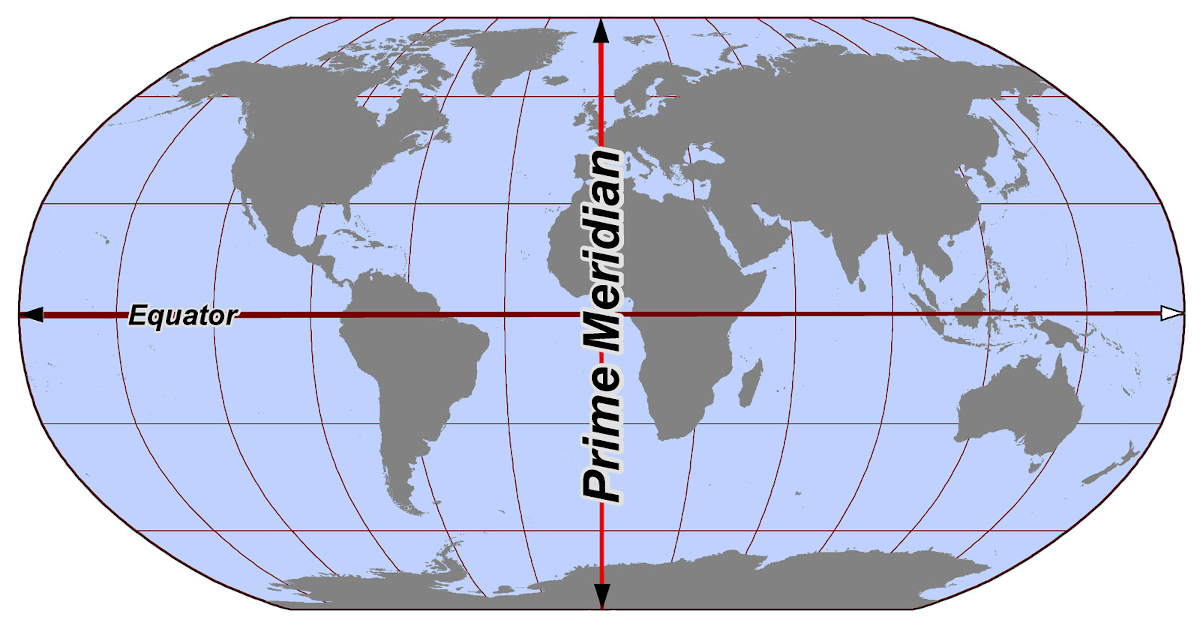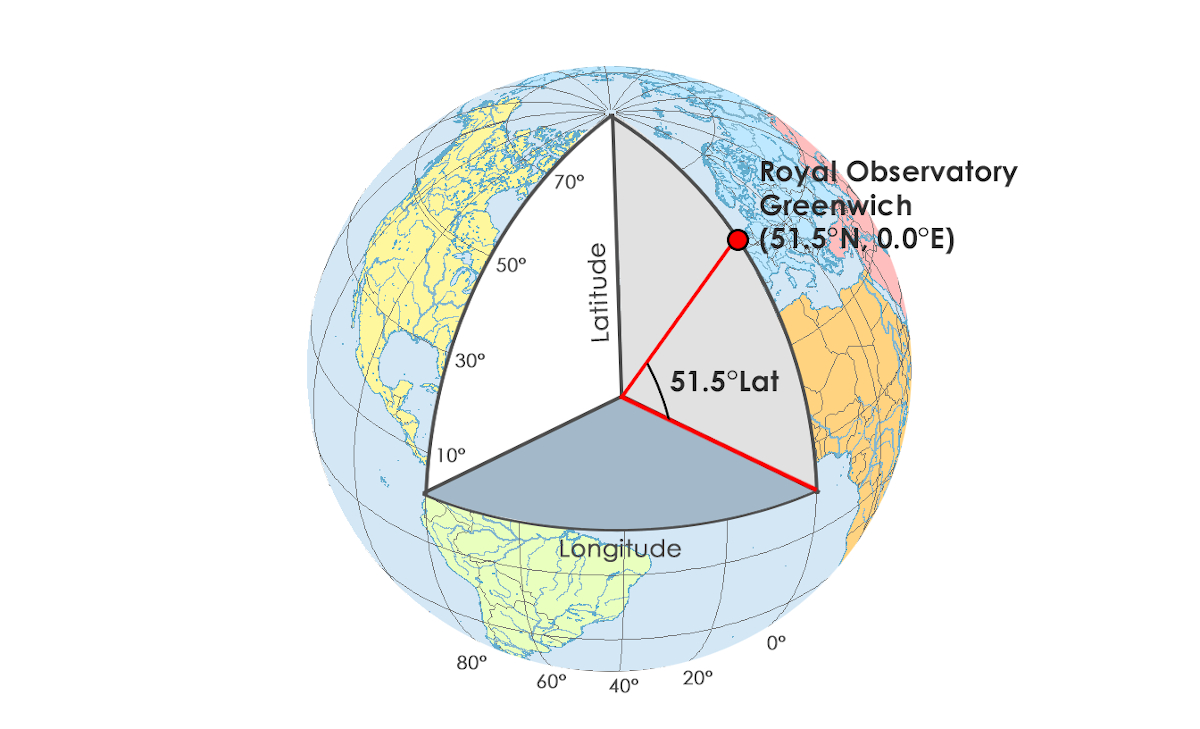Reading Positive And Negative Coordinates
We are often reliant on GPS co-ordinates existence delivered to our devices for locating places. With a picayune practice it's non hard to read a decimal latitude and longitude value to determine a rough position.
But first it's important to sympathize some key concepts.

The Prime Meridian divides the globe into Eastern and Western hemispheres, just as the equator divides the globe into Northern and Southern hemispheres. In the diagram above:
- Top right quadrant: Northern latitudes, Eastern longitudes
- Bottom right quadrant: Southern latitudes, Eastern longitudes
- Bottom left quadrant: Southern latitudes, Western longitudes
- Top left quadrant: Northern latitudes, Western longitudes
The Prime number Meridian is at 0 degrees longitude (neither East or W), but as the equator is at 0 degrees latitude (neither Due north or South).
The spot south of Ghana where the Prime Median and Equator intersect has the co-ordinates 0 degrees latitude and 0 degrees longitude.

To assist sympathise where degrees come from, imagine there is an imaginary betoken in the center of the Globe. You are standing on it, facing Greenwich in London.
By facing the Prime Summit line, you are facing 0 degrees longitude (neither East nor West). Now you lot demand to look up to face Greenwich. Information technology is that angle (the bending you need to await upwardly by to face up London) that represents its breadth, which is 51.5 degrees (North).
Let's at present look to the other side of the world… nigh… to Sydney, Australia. This time you demand to plow to your left (E) by 151.2093 degrees (longitude) and await downwards (South) by 33.8688 degrees (breadth).
Although information technology's a little more abstract to visualise, y'all can turn a maximum of 180 degrees from the prime number top (either East or West) and 90 degrees from the equator (North or South). Using a mix of the two, you will be facing some point on the earth from your imaginary point in the center.
Above, I reported Sydney as 33.8688° Southward (latitude), 151.2093° E (longitude).
You could have previously seen latitude and longitude positions reported with negative values (east.g. -33.8688,151.2093). This format is referred to as Decimal Degrees (DD) and is the most common format used today. It'south still in breadth,longitude format, but at present instead of using North or South for latitude, and Due east and West for longitude, +/- values are used.
Northern latitudes and Eastern longitudes are positive. Southern latitudes and Western longitudes are negative.
Hither are some instance of cities in each of the quadrants and their latitudes and longitudes reported in the ii ways described above:
- Summit right quadrant: Northern latitudes, Eastern longitudes
- e.g. Moscow = 55.7558° N, 37.6173° East (55.7558,37.6173)
- Bottom right quadrant: Southern latitudes, Eastern longitudes
- east.1000. Sydney = 33.8688° Due south, 151.2093° East (-33.8688,151.2093)
- Bottom left quadrant: Southern latitudes, Western longitudes
- e.g. Sao Paulo = 23.5558° S, 46.6396° W (-23.5558,-46.6396)
- Top left quadrant: Northern latitudes, Western longitudes
- e.g San Francisco = 37.7749° N, 122.4194° West (37.7749,-122.4194)
Y'all might have come up across other systems reporting breadth and longitude including; Degrees, Minutes, and Seconds (DMS) – the oldest format for geographic coordinates (though even so used extensively today (including in camera metadata).
For instance, here'south a snippet of the metadata from a GoPro 360 photo reporting latitude and longitude in DMS:
<Composite:GPSAltitude>2323.6 m Above Sea Level</Composite:GPSAltitude> <Composite:GPSDateTime>2019:11:29 13:06:48Z</Composite:GPSDateTime> <Composite:GPSLatitude>28 deg 17' 55.14" N</Composite:GPSLatitude> <Composite:GPSLongitude>16 deg 32' 44.90" West</Composite:GPSLongitude> <Blended:GPSPosition>28 deg 17' 55.14" Northward, 16 deg 32' 44.90" West</Composite:GPSPosition> You can see (after converting ASCII characters) the location reads 28 deg 17' 55.xiv" North (latitude) and 16 deg 32' 44.xc" Due west (longitude).
Breaking information technology downwards we take:
- 28 deg 17' 55.14" Northward (breadth)
- 28 degrees
- 17 minutes
- 55.14 seconds
- Due north
- 16 deg 32' 44.90" West (longitude)
- 16 degrees
- 32 minutes
- 44.90 seconds
- Due west
Degrees reported here are no different to the way previously described.
Minutes and seconds are where it gets tricky.
Let's kickoff with breadth. Endeavor and imagine lines circumvoluted the world in Northern latitudes from the equator to the North Pole each 1 caste apart.
In globe epitome above, you can meet some of these lines circling the globe representing 10°, thirty°, 50°, 70° latitude.
Between each of these degrees, at that place are hour (or threescore more than lines), and betwixt each minute is threescore seconds (or 60 minutes).
Degrees for latitude range from 0-90, minutes between 0 to 59 as integers and seconds betwixt 0 to 59.9999 (reported upwards to 8 decimal places – run into notation on accuracy below) with North or South value reported.
The aforementioned organisation is in place for latitude, the simply divergence being degrees range 0-180 with East or West values reported.
Converting to Decimal Degrees from Degrees, Minutes, and Seconds we can use the post-obit equation
So in my GoPro example (28 deg 17' 55.14" North, 16 deg 32' 44.ninety" W)
DD = d + g/60 + s/3600 lat DD = (28 + (17/lx) + (55.14/3600)) * 1 lat DD = 28.29865 (North, but if s * past -1) lon DD = (xvi + (32/60) + (44.90/3600)) * -1 lon DD = -16.5458055556 (West, so * by -1) Which gives us a DD latitude,longitude = 28.29865,-sixteen.5458055556.
A notation on accuracy
The number of decimal places reported in the latitude and longitude values is important, as information technology determines the precision of the location.
In a world without computers decimal places were a major consideration. As computerised GPS systems entered the market this became less of a business concern because computers can now easily report location to many decimal places from GPS readings.
The biggest effect with GPS accurateness today is down to the device and conditions.
A device might report to 8 decimal places (good for millimeter level accurateness), but if the measurement calculated by the GPS receiver based on satellite fixes is inaccurate so the measurement will exist reported to a high degree of accurateness, but is in fact non very authentic at all (come across GPS 101 for causes of inaccuracy).
Never miss an update
Sign up to receive new articles in your inbox as they published.
Talk over this post

Reading Positive And Negative Coordinates,
Source: https://www.trekview.org/blog/2021/reading-decimal-gps-coordinates-like-a-computer/
Posted by: boltonhicing.blogspot.com


0 Response to "Reading Positive And Negative Coordinates"
Post a Comment